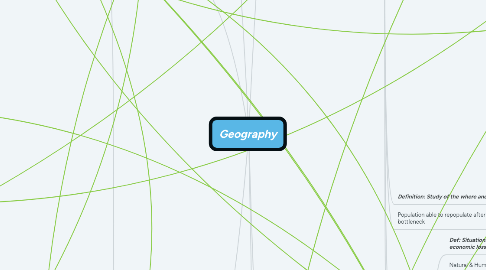
1. History
1.1. Colinialism
1.1.1. Idea that land was limitless
1.2. Very early Environmentalism
1.2.1. Modern Environmentalism
1.2.1.1. Sustainable Development
1.2.1.1.1. Today's Environmentalism
1.2.1.1.2. 80's and 90's
1.2.1.2. 50's, 60's and 70's
1.2.1.2.1. Brown issues
1.2.1.2.2. Realizing downsides of large economic growth
1.2.1.2.3. Cultural Ecology
1.2.1.2.4. Green Revolution
1.2.2. Early 1900's
1.2.2.1. Romanticizing Wilderness
1.2.2.2. Fear of running out of resources
1.3. Concepts of Nature
1.3.1. Urbanism
1.3.1.1. Over explooitation
1.3.2. Preservation
1.3.2.1. Conservation
1.3.2.1.1. Usage within limits of environment
1.3.2.2. No usage of environment
1.3.3. Socionature
1.3.3.1. Ecocentric
1.3.3.1.1. Values focused on non-human organisms
1.3.3.2. Contructivist
1.3.3.2.1. Nature has never been "natural"
1.3.3.2.2. Anthropgenic Landscapes
1.3.4. Possibilism
1.4. How to Study History
1.4.1. Archives
1.4.1.1. Documents
1.4.1.2. Oral History
1.4.2. Paleoclimate
1.4.3. Modern environment
1.4.3.1. Soils
1.4.3.2. Pollen
1.4.3.3. Ice Cores
1.4.3.4. Tree Rings
1.4.3.5. Geochronology
2. Geographers
2.1. Study of people living in different areas
3. Agricultrue
3.1. Systems
3.1.1. Traditional System
3.1.1.1. Pastoralism
3.1.1.1.1. Nomadic Hearding
3.1.1.1.2. Took into account of harsh environmental conditions
3.1.1.1.3. Perceived in Global North as inefficient and inferior
3.1.1.2. Prominent in Global South
3.1.1.2.1. Based on subsistence Ag.
3.1.1.3. Intensive Tradition
3.1.1.3.1. High Yields and heavy inputs
3.1.1.4. Shifting Cultivation (Swidden) (Slash - and -Burn)
3.1.1.4.1. Problematic when population is high or rapidly growing
3.1.1.5. Constraints
3.1.1.5.1. Reduced fallow time
3.1.1.5.2. Return to poly-cultural systems is difficult
3.1.1.5.3. Trend of alternative employment in urban areas
3.1.1.5.4. Soil erosion
3.1.2. Industrial and Plantation Ag.
3.1.2.1. Prominent in Global North
3.1.2.2. Monocultural
3.1.2.3. Uses
3.1.2.3.1. Fossil Fuels
3.1.2.3.2. GMO's
3.1.2.3.3. Fertilizers
3.1.2.3.4. Large amounts of water
3.1.2.4. Large commercial farming business
3.1.2.4.1. Family
3.1.2.4.2. Coorporate
3.1.2.5. Constraints
3.1.2.5.1. High yields = High inputs
3.1.2.5.2. Circle of poison created by pesticides and herbacides
3.1.2.5.3. Genetic Escape
3.1.2.5.4. Water Contamination
3.1.3. Green Revolution
3.1.3.1. Mixed Industrial and Traditional Systems
3.1.4. Agrosystems
3.1.4.1. Interaction between plants and pests
3.1.4.1.1. Helps keep diversity in systems
3.2. Famine & Hunger
3.2.1. Causes
3.2.1.1. Food Access
3.2.1.1.1. Do people have access to the food available
3.2.1.1.2. KEY to begin solving famine and hunger
3.2.1.2. Food Availibility
3.2.1.2.1. Is there food or not
3.2.1.3. Food Sovereignty
3.2.1.3.1. The right for people to have food
3.2.1.4. Food Self- Sufficency
3.2.1.4.1. People being able to produce their own food and meet consumption needs
3.2.1.5. Food Security
3.2.1.5.1. Having food to meet nutritional needs
4. Physical
4.1. Realms
4.1.1. Hydrosphere
4.1.1.1. Water
4.1.1.1.1. Water Cycle
4.1.1.1.2. Covers 70% of Earth's surface
4.1.1.1.3. Hydraulic Technology
4.1.2. Atmosphere
4.1.2.1. Air
4.1.2.1.1. Stratospheric Ozone Depletion
4.1.3. Lithosphere
4.1.3.1. Ground
4.1.4. Biosphere
4.1.4.1. Biogeography
4.1.4.1.1. Focus on Patterns in environment
4.1.4.2. Ecology
4.1.4.2.1. Biomes
4.1.4.2.2. Def: Focus on Relationships between organisms and physical environment
4.1.4.3. Life
4.2. Definition: Study of the where and why of Earth
4.3. Population able to repopulate after a bottleneck
4.4. Hazzards
4.4.1. Def: Situations that can cause injury, disease, economic loss, or environmental damage
4.4.2. Natural & Human created causes
4.4.3. Hazard Risk
4.4.3.1. Risk NOT equally shared
4.4.3.2. Risk Perception
4.4.3.2.1. Prior Experience
4.4.3.2.2. Fast moving hazards VS. Slow moving hazards
4.4.3.2.3. Economic Situation
4.4.3.2.4. Vulnerability
4.4.3.3. Adaptation
4.4.3.3.1. Def: How people recover from shock
4.4.3.3.2. Coping
4.4.3.3.3. Long term
4.5. Geologists
4.5.1. Focus on study of Earth in general
5. Human Relationship
5.1. Social Darwinism
5.1.1. Inferiority of some races in an environment
5.2. Environmental Determanism
5.3. Environmental Justice
5.3.1. Effects of industrialization on people of color
5.3.2. Unequal distribution of risk exposure
5.3.3. Environmental Equity
5.3.3.1. Geographic
5.3.3.2. Social Equity
5.3.3.3. Procedural
5.3.3.4. Generational
5.3.4. Environmental Racism
5.3.4.1. Correct past injustices
5.3.4.2. NIMBY
5.3.4.3. BANANA
5.3.4.3.1. Build absolutely nothing anywhere near nobody
5.4. Feminist Political Ecology
5.4.1. Differing experiences from men and women
5.4.2. Special attention to:
5.4.2.1. Age
5.4.2.2. Class
5.4.2.3. Ethnicity
5.4.2.4. Linguistics
5.5. POPULATION
5.5.1. Paul Ehrilich (1968)
5.5.1.1. NeoMalthusian
5.5.1.2. Population bomb in the global South
5.5.2. Structuralist Perspective
5.5.2.1. Engles
5.5.2.1.1. Individuals benefit through labor
5.5.3. Neostructuralist
5.5.3.1. Hoarding resources = scarcaties
5.5.3.2. Boderup
5.5.3.2.1. Greater productivity comes from population increases
5.5.3.3. Harvey
5.5.3.3.1. Why do people only consider population and resources
5.5.4. Malthus
5.5.4.1. Population grows exponentially, food production is geometric
5.5.4.1.1. Proven wrong by Esther Borerup
5.5.5. Cornucopian / Technocratic
5.5.5.1. Technology will overcome resource contraints
5.5.5.2. Simon
5.5.5.2.1. Innovation comes from free markets and rising prices
5.5.5.2.2. Focuses on economic substitute
5.5.5.3. Lamberg
5.5.5.3.1. Environmental issues are not supported by relevant data
5.5.6. I= PAT equation
5.5.6.1. Impact = Population * Affluence * Technology
5.5.6.2. Criticisms
5.5.6.2.1. More population does NOT equal more of an impact
5.5.6.2.2. Humans are just considered predators to the environment
5.5.6.2.3. Equation doesn't account for conservation and preservation
5.5.7. Demographic Transition
5.5.7.1. Birth rate & Fertility fall with education + affluence
5.5.7.2. Demographic Change
5.5.7.2.1. Fertility
5.5.7.2.2. Immigration & Emigration
6. Economic
6.1. GDP
6.1.1. Environmental Degradation ( Huntington & Semple
6.1.1.1. GDP and Env. Degradation decouple after societies have developed or are becoming more developed (AKA reach a turning point)
6.1.1.1.1. Environmental Kuznet's Curve
6.2. GNI
6.3. Modernization Theory
6.3.1. European innovation key to economic growth
6.3.2. Will usually fall as education and affluence increases
6.4. Dependency Theory
6.4.1. Global North made Global South dependent
6.4.1.1. Underdevelopment
6.4.1.2. Mercantilism
6.4.2. Dualism
6.4.2.1. Development of area at the expense of another
6.4.2.1.1. Parisitism
6.5. World Systems Theory
6.5.1. 3 realms of nations
6.5.1.1. Core
6.5.1.1.1. Most Developed
6.5.1.2. Semi periphery
6.5.1.2.1. Emerging Nations
6.5.1.3. Periphery
6.5.1.3.1. Developing Global South
6.5.2. Structualism
